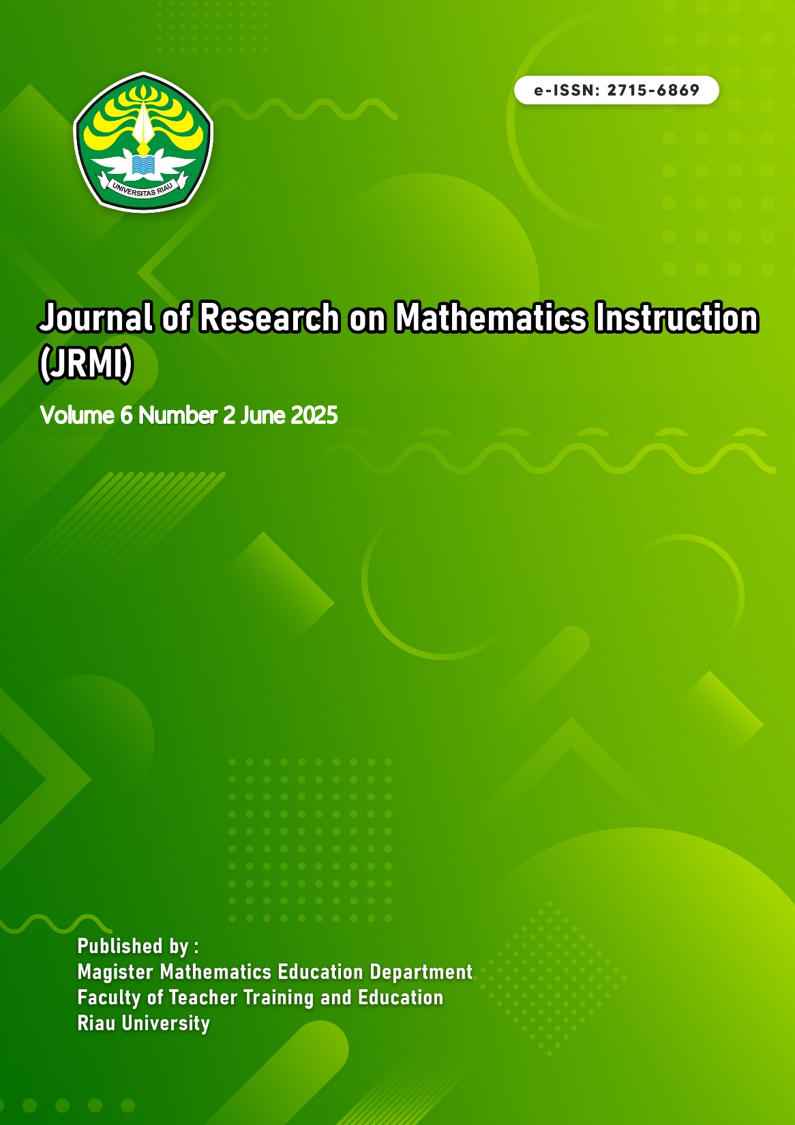Multivariate Statistical Approach: Factor Analysis of Scabies Incidence in the Working Area of Bea Muring Health Center
Abstract
This study aims to demonstrate the application of factor analysis as one of the multivariate statistical methods in processing epidemiological data. Factor analysis is employed to reduce a set of correlated variables into simpler factors, thereby enabling more efficient identification of inter-variable relationship patterns. The data were obtained from surveys conducted within communities experiencing specific epidemiological cases, and were subsequently analyzed using validity testing, reliability testing, the Kaiser-Meyer-Olkin (KMO) measure, and Bartlett’s Test of Sphericity as prerequisites for analysis. The results indicate that out of the initial 19 variables, 15 met the criteria and were reduced into three main factors, explaining a total variance of 74.79%. Factor 1 accounted for 44.45% of the variance, Factor 2 for 18.08%, and Factor 3 for 12.25%. These findings highlight the effectiveness of factor analysis in reducing the dimensionality of epidemiological data while identifying dominant factors influencing the observed phenomenon. In conclusion, this study demonstrates the potential of factor analysis as a relevant multivariate statistical method for handling complex data in public health as well as other applied fields.
References
R. Husna, T. Joko, and N. Nurjazuli, “Faktor Risiko Yang Mempengaruhi Kejadian Skabies Di Indonesia : Literatur Review,” J. Kesehat. Lingkung., vol. 11, no. 1, pp. 29–39, 2021, doi: https://doi.org/10.47718/jkl.v11i1.1340.
I. Halid, M. Halid, and B. B. B. Susilo, “Prevalences and Determinants Analysis of Scabies Incidence in Rumak Village,” Med. Technol. Public Heal. J., vol. 8, no. 2, pp. 186–195, 2024, doi: https://doi.org/10.33086/mtphj.v8i2.5642.
T. Iskandar, “Masalah Skabies pada Hewan dan Manusia Serta Penanggulangannya,” Wartazoa, vol. 10, no. 1, pp. 28–34, 2000.
W. Zhang et al., “Trends in Prevalence and Incidence of Scabies from 1990 to 2017: Findings from the Global Burden of Disease Study 2017,” Emerg Microbes Infect, vol. 9, no. 1, pp. 813–816, 2020, doi: 10.1080/22221751.2020.1754136.
M. D. Aždajić, I. Bešlić, A. Gašić, N. Ferara, L. Pedić, and L. Lugović-Mihić, “Increased Scabies Incidence at the Beginning of the 21st Century: What Do Reports from Europe and the World Show?,” Life, vol. 12, no. 10, pp. 1–15, 2022, doi: 10.3390/life12101598.
H. Ibadurrahmi, S. Veronica, and N. Nugrohowati, “Faktor-Faktor yang Berpengaruh Terhadap Kejadian Penyakit Skabies pada Santri di Pondok Pesantren Qotrun Nada Cipayung Depok Februari Tahun 2016,” J. Profesi Med., vol. 10, no. 1, pp. 33–45, 2016, doi: https://doi.org/10.33533/jpm.v10i1.12.
L. Lugović-Mihić et al., “An Increasing Scabies Incidence in Croatia: A Call for Coordinated Action Among Dermatologists, Physicians and Epidemiologists,” Zdr Varst, vol. 59, no. 4, pp. 264–272, 2020, doi: 10.2478/sjph-2020-0033.
N. Hidayat, A. Nurapandi, S. U. Asmarani, and H. Setiawan, “Association between Personal Hygiene Behavior and Sleeping Quality on Scabies Incidence,” Int. J. Nurs. Heal. Serv., vol. 5, no. 4, pp. 351–359, 2022, doi: https://doi.org/10.35654/ijnhs.v5i4.610.
L. Sürücü, İ. Yikilmaz, and A. Maslakçi, “Exploratory Factor Analysis (EFA) in Quantitative Researches and Practical Considerations,” GÜSBD, vol. 13, no. 2, pp. 947–965, 2024, doi: 10.31219/osf.io/fgd4e.
A. Baroroh, Analisis Multivariat dan Time series dengan SPSS 21. Jakarta: Elex Media Komputindo, 2013.
S. Ririhena and S. B. Loklomin, “Pendekatan Principal Component Analysis pada Data Demam Berdarah Dengue di Provinsi Maluku Utara,” BAREKENG J. Ilmu Mat. dan Terap., vol. 14, no. 4, pp. 557–564, 2020, doi: https://doi.org/10.30598/barekengvol14iss4pp557-564.
K. J. Dunn and G. McCray, “The Place of the Bifactor Model in Confirmatory Factor Analysis Investigations Into Construct Dimensionality in Language Testing,” Front. Psychol., vol. 11, pp. 1–16, 2020, doi: 10.3389/fpsyg.2020.01357.
B. van Deursen et al., “Increasing Incidence of Reported Scabies Infestations in the Netherlands, 2011-2021,” PLoS One, vol. 17, no. 6, pp. 1–8, 2022, doi: 10.1371/journal.pone.0268865.
M. Treviño et al., “How Do We Measure Attention? Using Factor Analysis to Establish Construct Validity of Neuropsychological Tests,” Cogn. Res. Princ. Implic., vol. 6, no. 1, pp. 1–26, 2021, doi: 10.1186/s41235-021-00313-1.
E. Nasti, T. H. Setiawan, H. Warianto, A. Andi, and G. Gerry, “Faktor-Faktor yang Mempengaruhi Tingkat Kecerdasan Emosional Anak Terhadap Pelajaran Matematika dengan Menggunakan Analisis Faktor,” J. Lebesgue J. Ilm. Pendidik. Mat. Mat. Dan Stat., vol. 3, no. 1, pp. 44–59, 2022, doi: 10.46306/lb.v3i1.72.
N. Sakib et al., “Psychometric Validation of the Bangla Fear of COVID-19 Scale: Confirmatory Factor Analysis and Rasch Analysis,” Int. J. Ment. Health Addict., vol. 20, no. 5, pp. 2623–2634, 2022, doi: 10.1007/s11469-020-00289-x.
Sugiyono, Metode Penelitian Kuantitatif, Kualitatif, dan R&D. Bandung, Indonesia: Alfabeta, 2021.
S. Santoso, Statistik Multivariat: Konsep dan Aplikasi dengan SPSS. Jakarta: Elex Media Komputindo, 2010.
H. Taherdoost, “Validity and Reliability of the Research Instrument; How to Test the Validation of a Questionnaire/Survey in a Research,” Int. J. Acad. Res. Manag., vol. 5, no. 3, pp. 28–36, 2016, doi: Taherdoost, Hamed, Validity and Reliability of the Research Instrument; How to Test the Validation of a Questionnaire/Survey in a Research (August 10, 2016). Available at SSRN: https://ssrn.com/abstract=3205040 or http://dx.doi.org/10.2139/ssrn.3205040.
J. A. Radjah, A. Aden, Ilmadi, N. Valentina, and Isnurani, “Analisis Faktor-Faktor yang Mempengaruhi Kualitas Kerja Mahasiswa Praktek Menggunakan Metode Analisis Faktor di CV. Rama Teknik,” J. Lebesgue J. Ilm. Pendidik. Mat. Mat. Dan Stat., vol. 2, no. 1, pp. 69–84, 2021, doi: https://doi.org/10.46306/lb.v2i1.57.
C. L. Kimberlin and A. G. Winterstein, “Validity and Reliability of Measurement Instruments Used in Research,” Am. J. Heal. Pharm., vol. 65, no. 23, pp. 2276–2284, 2008, doi: https://doi.org/10.2146/ajhp070364.
M. O. Astuti, R. D. Guntur, A. Atti, E. B. Sinu, and D. Kusumaningrum, “Analisis Pearson Chi-Square pada Faktor-Faktor yang Berhubungan dengan Kejadian Stunting,” J. Innov. Res. Knowl., vol. 3, no. 11, pp. 2197–2210, 2024, doi: https://doi.org/10.53625/jirk.v3i11.7632.
M. Alavi, D. C. Visentin, D. K. Thapa, G. E. Hunt, R. Watson, and M. Cleary, “Chi-Square for Model Fit in Confirmatory Factor Analysis,” J. Adv. Nurs., vol. 76, no. 9, p. 2209=2211, 2020, doi: https://doi.org/10.1111/jan.14399.
A. B. Astuti, A. N. Guci, V. I. A. Alim, L. N. Azizah, M. K. Putri, and W. Ngabu, “Non Hierarchical K-Means Analysis to Clustering Priority Distribution of Fuel Subsidies in Indonesia,” BAREKENG J. Ilmu Mat. dan Terap., vol. 17, no. 3, pp. 1663–1672, 2023, doi: https://doi.org/10.30598/barekengvol17iss3pp1663-1672.
Z. Zhang, T. Sangsawang, K. Vipahasna, and M. Pigultong, “A Mixed-Methods Data Approach Integrating Importance-Performance Analysis (IPA) and Kaiser-Meyer-Olkin (KMO) in Applied Talent Cultivation,” J. Appl. Data Sci., vol. 5, no. 1, pp. 256–267, 2024, doi: https://doi.org/10.47738/jads.v5i1.170.
M. Tavakol and A. Wetzel, “Factor Analysis: A Means for Theory and Instrument Development in Support of Construct Validity,” Int. J. Med. Educ., vol. 11, pp. 245–247, 2020, doi: 10.5116/ijme.5f96.0f4a.
D. Goretzko, T. T. H. Pham, and M. Bühner, “Exploratory Factor Analysis: Current Use, Methodological Developments and Recommendations for Good Practice,” Curr. Psychol., vol. 40, pp. 3510–3521, 2021, doi: https://doi.org/10.1007/s12144-019-00300-2.
A. R. Hashmia, N. A. Amiraha, and Y. Yusof, “Organizational Performance with Disruptive Factors and Inventory Control as a Mediator in Public Healthcare of Punjab, Pakistan,” Manag. Sci. Lett., vol. 11, pp. 77–86, 2021, doi: 10.5267/j.msl.2020.8.028.
I. Mosly, “Factors Influencing Safety Performance in the Construction Industry of Saudi Arabia: An Exploratory Factor Analysis,” Int. J. Occup. Saf. Ergon., vol. 28, no. 2, pp. 901–908, 2020, doi: https://doi.org/10.1080/10803548.2020.1838774.
Copyright (c) 2025 Journal of Research on Mathematics Instruction (JRMI)

This work is licensed under a Creative Commons Attribution-NonCommercial-ShareAlike 4.0 International License.






